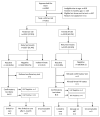On Campus HIV Self-Testing Distribution at Tertiary Level Colleges in Zimbabwe Increases Access to HIV Testing for Youth
- PMID: 36243558
- PMCID: PMC7614942
- DOI: 10.1016/j.jadohealth.2022.09.004
On Campus HIV Self-Testing Distribution at Tertiary Level Colleges in Zimbabwe Increases Access to HIV Testing for Youth
Abstract
Purpose: HIV self-testing allows youth to access testing outside of healthcare facilities. We investigated the feasibility of peer distribution of HIV self-testing (HIVST) kits to youth aged 16-24 years and examined the factors associated with testing off-site rather than at distribution points.
Methods: From July 2019 to March 2020, HIVST kits were distributed on 12 tertiary education campuses throughout Zimbabwe. Participants chose to test at the HIVST distribution point or off-site. Factors associated with choosing to test off-site and factors associated with reporting a self-test result for those who tested off-site were investigated using logistic regression.
Results: In total, 5,351 participants received an HIVST kit, over 129 days, of whom 3,319 (62%) tested off-site. The median age of recipients was 21 years (interquartile range 20-23); 64% were female. Overall, 2,933 (55%) returned results, 23 (1%) of which were reactive. Being female (adjusted odds ratio [aOR] 1.16, 95% confidence interval [CI] 1.03-1.31), living on campus (aOR 1.24, 95% CI 1.09-1.40), used a condom at last sex (aOR 1.44, 95% CI 1.26-1.65), and previous knowledge of HIVST (aOR 1.22, 95% CI 1.09-1.37) were associated with off-site testing. Attending a vocational college and teachers training college compared to a university was associated with choosing to return results for those who tested off-site (OR 2.40, 95% CI 1.65-3.48, p < .001).
Discussion: HIVST distribution is an effective method of reaching a large number of youth over a short period of time. Efforts to increase awareness and roll out of HIVST on campuses should be coupled with support for linkage to HIV prevention and treatment services.
Keywords: HIV self-test; Tertiary educational institutions; Youth.
Copyright © 2022 Society for Adolescent Health and Medicine. Published by Elsevier Inc. All rights reserved.
Conflict of interest statement
Figures
References
-
- UNAIDS. UNAIDS data 2020. 2020. [Accessed March 15, 2021]. Available at: https://www.unaids.org/sites/default/files/media_asset/2020_aids-data-bo....
-
- Ministry of Health and Child Care Z. Zimbabwe population-based HIV impact assessment ZIMPHIA 2015—2016. 2016. [Accessed June 13, 2017]. Available at: http://phia.icap.columbia.edu/wp-content/uploads/2016/11/ZIMBABWE-Factsh....
-
- World Health Organisation. Rapid HIV tests: Guidelines for use in HIV testing and counselling services in resource-constrained settings. World Health Organization; Geneva, Switzerland: 2004.
Publication types
MeSH terms
Grants and funding
LinkOut - more resources
Full Text Sources
Medical



